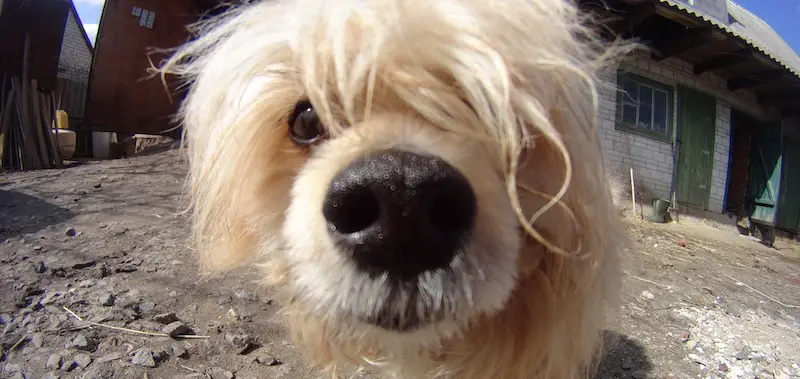Written by Dr. Ivana Crnec, DVM ; Last Updated by Matt Clayton 3 Weeks Ago
Grooming is an integral part of the dog parenting experience. Although some dog owners prefer visiting the groomer’s saloon, others enjoy grooming their dogs at home.
When it comes to grooming, the first thing you need to remember is that every dog needs to be groomed. The only difference between dogs is the grooming frequency and the amount of time that needs to be spent on each grooming session.
Grooming may seem simple, but it does come with specific guidelines and instructions that need to be followed. In this article, we will explain how to groom your dog – the necessary tools, steps, the do’s and the do not’s.
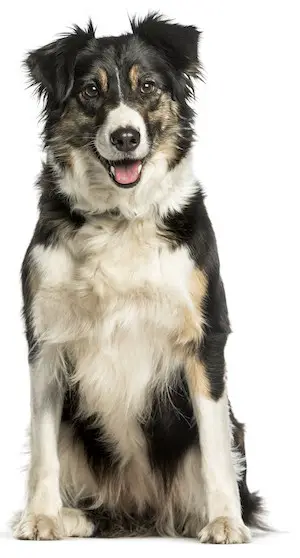
How to Groom a Dog at Home –
10 Simple Steps to Take
Before going through the 10 basic steps of DIY dog grooming, we need to emphasize the importance of your dog’s willingness to collaborate during the session.
You can have the best grooming kit available on the market and read every grooming blog accessible online, but if your dog refuses to be handled, the grooming session is doomed.
To avoid this, you should start grooming your dog at an early age, preferably while still a puppy. At this point, you do not have to follow all 10 steps; just mimic them – the goal is to get your dog used to being handled.
With this covered, it is time to start explaining the 10 simple grooming steps.
1. Be Prepared – Get the Grooming Tools & Treats Ready
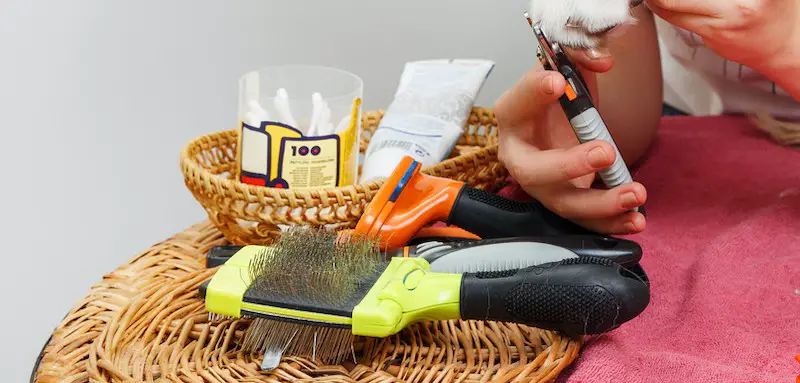
Before you start the actual grooming procedure, you need to make sure you have all grooming tools at hand (including plenty of treats for bribing your dog).
If you have an assistant, things will be more straightforward, but if working alone, you need to simplify things before you begin.
Here is a short checklist of the things you need:
- Brushes (different types and preferably a flea comb)
- Scissors (various types or one universal) and/or hair clippers
- Nail clipper and file or grinder
- Eye cleansing solution
- Ear cleaning solution
- Shampoo and conditioner
- Toothpaste and toothbrush
- Doggy wax or organic coconut oil
- Towels
- Cotton balls, sponges, or washcloths
- Hairdryer.
Being well-prepared also includes choosing a nice grooming location. You need a spacious, quiet, and calm environment. It should be enclosed and secure, so it does not support your dog’s escapism plans.
Vet Tip:
If your dog is generally hyperactive, you can tire him down before the grooming session. In more extreme cases, you can use natural calming chews. However, never give your dog anything before consulting with your trusted veterinarian.
2. Clean Dog’s Eyes – How to Clean Dog’s Eyes?
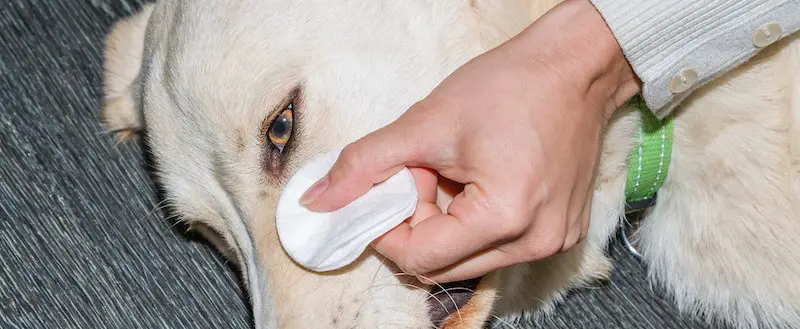
Depending on your dog’s breed and tearing intensity, cleaning the eye might be something you will do daily and not just when it is grooming time.
Regardless of the eye cleaning frequency, the concept and technique are the same.
- You can clean your dog’s eyes with a cotton ball, sponge, or washcloth dipped in lukewarm water.
- If there are heavy boogers on the corners of the eye, you can press the moistened cotton or cloth over the booger to soften it.
- Alternatively, you can use dog-friendly eye drops or a simple saline solution. Once the boogers are soft, you can just wipe them away.
Never use napkins or paper towels when cleaning your dog’s eyes. These materials disintegrate quickly, and if a small part is left within the eye, it may cause irritation.
Vet Tip:
Never use chamomile tea to clean your dog’s eyes. There is a popular misconception that chamomile tea has a soothing effect on the eyes and can help keep them clean and healthy.
The truth is, chamomile makes an ideal breeding ground for bacteria, and if used for eye washing, it can lead to serious eye irritations and infections. Instead, you can use few drops of organic coconut oil.
3. Clean Dog’s Ears – How to Clean Dog’s Ears?
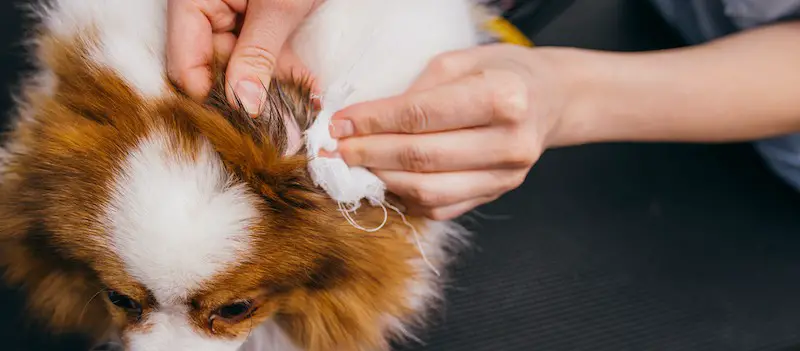
The dog’s ears have specific anatomy that protects the hearing apparatus from injuries. However, that particular anatomy also supports wax, debris, and foreign material accumulation within the ear canal.
Cleaning your dog’s ears is more straightforward than it sounds.
- All you need to do is use dog wipes or moist cotton or washcloth and remove the visible debris accumulated in the inner portion of the ear flap. Instead of water, you can use a dog ear cleansing solution for moistening.
- Never try cleaning the inside of the canal.
- When cleaning your dog’s ears, pay attention to the presence of hair within the canal. Too much hair prevents proper ventilation and create a good environment for infections. If there are hairs, try plucking them with your finger or tweezers (a professional groomer would use wax, but this is not part of the DIY grooming procedure).
Also, never use human cotton tips. As mentioned, the dog’s ear anatomy is different than ours, and by using cotton swabs, you risk injuring your dog’s eardrum.
Vet Tip:
Never use ear solutions if you suspect something wrong is going on with your dog’s ear.
Ear infections and foreign objects can puncture the eardrum, and using ear solutions in a dog with a punctured eardrum can be detrimental. If your dog’s ears are overly dirty or itchy, schedule an urgent appointment with your vet.
4. Clean Dog’s Nose – How to Clean Dog’s Nose?
The dog’s nose should be well-moist most of the time and free from any discharge.
Keeping your dog’s nose clean includes two steps: wiping away any discharges and maintaining proper hydration.
- For discharge removal, you can use a clean and moist towel or washcloth. When removing the discharge, pay attention to the type of discharge (white, translucent, smelly, or sticky).
- As for hydration, it is advisable to use wax formulated for dogs or organic coconut oil. These substances will create a protective layer over the nose and keep it well-moisturized.
Vet Tip:
Contrary to popular belief, a dry nose does not mean your dog is sick.
The dog’s nose moisture varies during the day and depends on several factors, including air humidity, sun exposure, and hot environments. However, if your dog’s nose seems to be constantly dry or even cracked, do not hesitate to seek veterinary attention.
5. Brush your dog’s teeth – How to brush dog’s teeth?
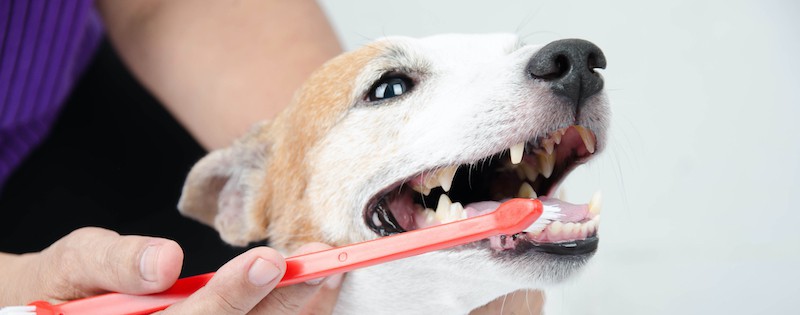
When it comes to teeth brushing, there are two fundamental concerns – brushing equipment and brushing frequency.
By brushing equipment, we refer to a toothbrush designed for dogs and a toothpaste formulated for dogs. Using human alternatives is a big no-no.
Human toothbrushes have hard bristles that can easily damage the dog’s sensitive gums. Plus, their design is not suited for the dog’s mouth anatomy, making the brushing a bit challenging.
Human toothpaste is even more dangerous. Namely, most formulas contain an artificial sweetener called xylitol. Xylitol is highly toxic to dogs, and since you cannot tell your dog to spit instead of swallow, intoxication is a very plausible scenario.
Thankfully, the modern pet market offers an array of brushes and pastes for dogs. Most pastes feature dog-friendly tastes like chicken, beef, or peanut butter.
- In terms of frequency, the basic rule of thumb is that the teeth need to be brushed no less than three times per week. In terms of oral health, brushing less frequently is the same as not brushing at all.
Vet Tip:
If you start noticing plaque accumulation on your dog’s teeth, it is time to take the problem to the next level and schedule teeth scaling at your trusted vet’s.
This does not mean you should stop brushing your dog’s teeth. Brushing is one and scaling another aspect of oral health.
6. Brush Your Dog’s Coat – How to Brush Dog’s Coat?
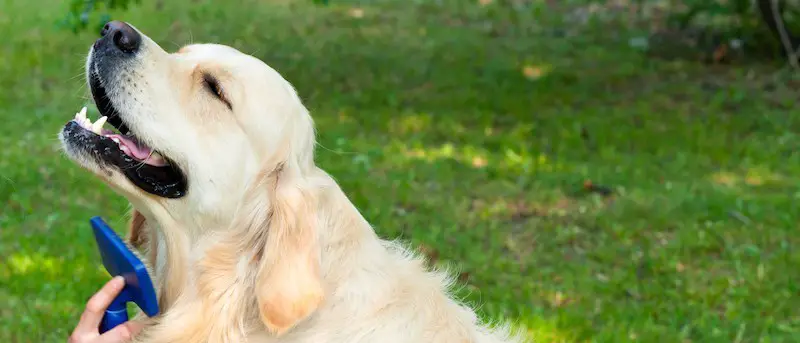
Brushing is of paramount importance. In addition to preventing mats and tangles (which can lead to skin irritations and infections), brushing improves blood circulation and promotes new hair growth. It also helps distribute the skin oil evenly.
- When brushing your dog’s coat, you need to use a brush suited for the specific coat types.
- It would also help if you have differently sized brushes for the different body parts – you cannot brush facial hairs with the same brush you are using on the back.
- Finally, when brushing, make a routine and stick to it. For example, always start with the back and belly, then legs, then tail, and finally head. Following a certain pattern will ensure there is no area of the body left un-brushed.
Vet Tip:
To improve your dog’s overall coat quality, in addition to regular brushing, make sure you provide your dog with a high-quality diet.
If possible, supplement your dog with fish oil. Wild-caught, cold-water fish oil (salmon or mackerel) is an excellent source of omega 3 fatty acids, which promote shiny and healthy skin and coat.
7. Trim Your Dog’s Coat – How to Trim Dog’s Coat?
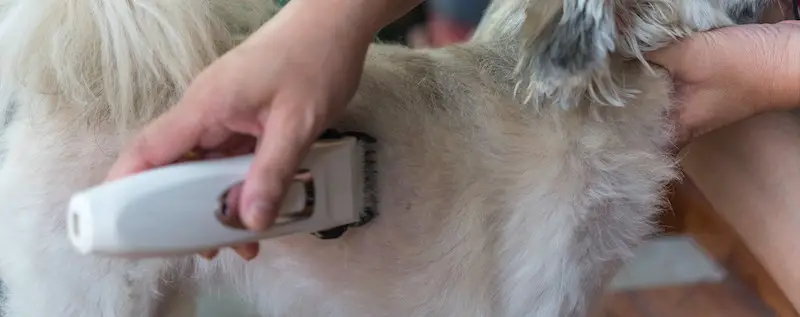
To trim your dog’s coat based on the breed’s standard recommendation, you need to do some extensive reading. Once you are theoretically prepared, you should take the clippers and scissors and start shaping.
As already mentioned, it is pivotal that you use clippers designed for dogs. Human clippers can cause skin burns and are usually not powerful enough. In addition to clippers, you need high-quality scissors.
There are several types of scissors, and each serves a different purpose. For example, there are thinning scissors, curved scissors, round-tipped scissors, and straight scissors. The straight scissors are a universal tool and suitable for all coat types.
Vet Tip:
Remember that certain parts of your dog’s body are more sensitive and require extra care. The thinnest and most delicate body areas include the face, eyes, belly, armpits, and genital and butt areas. Improper handling of these parts can lead to bruising or even cutting injuries.
8. Clean & Moisturize Your Dog’s Paws
The dog’s paws have a vital protective function, but just because they seem solid and enduring does not mean they do not require regular care.
- You can use a clean and damp cloth to clean the paw pads and the area between them.
- Once the paws are cleaned, you need to apply a protective moisturizer. This is important because the dog’s pads are prone to drying and cracking. Cracked pads are painful and cannot perform their protective function.
- You can use organic coconut oil or a paw pad wax explicitly formulated for dogs for moisturizing purposes. The coconut oil is hydrating, but the wax offers prolonged protection because it literally seals the skin pores and keeps the potential irritants at bay.
Vet Tip:
As you have probably noticed, the dog’s paws have a unique smell – something like corn chips or popcorns.
This smell is due to the specific microorganisms living on the paw skin surface. If this smell changes or becomes too intense, it is advisable to schedule an appointment with your trusted vet, as your dog might be suffering from bacterial or yeast overgrowth.
9. Cut Your Dog’s Nails – How to Trim Dog’s Nails?
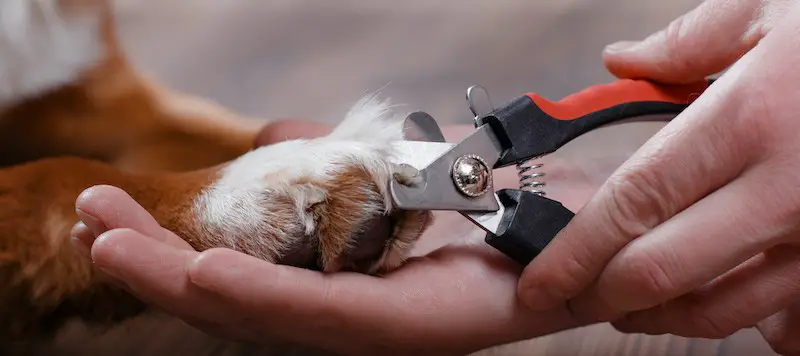
If you can hear your dog’s nails clicking on the floor when it walks, it is time for nail cutting. To be able to cut your dog’s nails, you need a short walkthrough of the nail anatomy.
Basically, the dog’s nail consists of two parts – a soft center (called the quick), where the nerves and blood vessels are located, and an outer casing or protective shell. The outer case can be translucent or pigmented.
In dogs with a translucent casing, the quick is easily visible, while in dogs with a pigmented case, you will have to work without being able to visualize the quick.
- For the cutting itself, you can choose between a nail clipper and a nail grinder.
- Simply put, the nail clipper is simpler to use, but it tends to leave uneven ends (thus requiring a nail file).
- On the other hand, the grinder allows more precise and refined work, but it usually produces a buzzing sound many dogs do not find pleasing.
Vet Tip:
If you accidentally cut your dog’s nail too short and see blood, do not panic.
Nails tend to bleed a lot, but a cut nail is not a life-threatening situation. The bleeding will stop eventually, but if you want, you can dip the short-cut nail in baby soap or cooking flour as these substances will make a plug over the quick and stop the bleeding faster.
10. Bathe, Dry, and Style Your Dog’s Fur
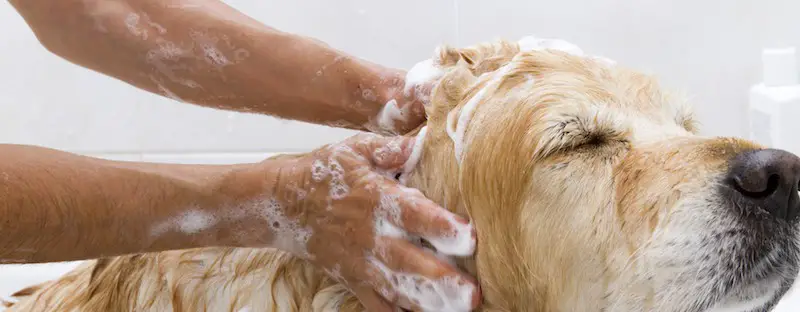
Bathing, drying, and fur styling are the finishing touch of the grooming session. While some dogs enjoy the bathing part more than others, all dogs need it.
It is essential to use a shampoo specific to your dog’s coat type. In addition to shampoo, you can use a coat conditioner or special moisturizer.
It goes without saying that human shampoos and conditioners are not suited for dogs. Even baby products need to be avoided. The same applies to cheap dog shampoos. It is advisable to invest in high-quality bathing products.
- Once the bath is over, you need to dry your dog thoroughly. This part can be tricky as moisture tends to get trapped beneath the fur and, if left there, causes issues.
- You can first towel-dry your dog and then use a hairdryer. If using the hairdryer, do not set it at the highest temperature and keep it at a safe distance – the goal is to get your dog dried, not burned.
- The fur styling part depends on the breed and, of course, on your dog’s personality. If you are not sure which hairstyle suits your dog most, do not be afraid to do some experimenting.
Vet Tip:
Frequent bathing can disrupt the balance of the natural microorganisms on the skin, leading to a myriad of skin and coat problems.
To avoid such problems, do not over-bathe your dog – save the bathing tickets for when your dog is filthy and for when it needs coat trimming and styling.
Summing Up
Grooming your dog is essential for not only their looks but especially their health. Some dog owners prefer taking their pet to be groomed by a professional at a grooming salon, but in the long run, it can get expensive.
You can easily groom your dog at home with a few key tools and maybe a few Youtube videos to learn everything you need. If your dog is used to being handled, trimming the coat, bathing, and taking care of the ears, eyes, and nose is not difficult at all.
Many dog owners simply think of it as a natural part of taking care of their dog – just as you would do with kids. And while doing so, you can save a lot of money to pamper your dog with treats and toys.

